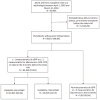Trends in nephrology referral patterns for patients with chronic kidney disease: Retrospective cohort study
- PMID: 35951609
- PMCID: PMC9371302
- DOI: 10.1371/journal.pone.0272689
Trends in nephrology referral patterns for patients with chronic kidney disease: Retrospective cohort study
Abstract
Introduction: Information on early, guideline discordant referrals in nephrology is limited. Our objective was to investigate trends in referral patterns to nephrology for patients with chronic kidney disease (CKD).
Methods: Retrospective cohort study of adults with ≥1 visits to a nephrologist from primary care with ≥1 serum creatinine and/or urine protein measurement <180 days before index nephrology visit, from 2006 and 2019 in Alberta, Canada. Guideline discordant referrals were those that did not meet ≥1 of: Estimated glomerular filtration rate (eGFR) ˂ 30 mL/min/1.73m2, persistent albuminuria (ACR ≥ 300 mg/g, PCR ≥ 500 mg/g, or Udip ≥ 2+), or progressive and persistent decline in eGFR until index nephrology visit (≥ 5 mL/min/1.73m2).
Results: Of 69,372 patients with CKD, 28,518 (41%) were referred in a guideline concordant manner. The overall rate of first outpatient visits to nephrology increased from 2006 to 2019, although guideline discordant referrals showed a greater increase (trend 21.9 per million population/year, 95% confidence interval 4.3, 39.4) versus guideline concordant referrals (trend 12.4 per million population/year, 95% confidence interval 5.7, 19.0). The guideline concordant cohort were more likely to be on renin-angiotensin system blockers or beta blockers (hazard ratio 1.14, 95% confidence interval 1.12, 1.16), and had a higher risk of CKD progression (hazard ratio 1.09, 95% confidence interval 1.06, 1.13), kidney failure (hazard ratio 7.65, 95% confidence interval 6.83, 8.56), cardiovascular event (hazard ratio 1.40, 95% confidence interval 1.35,1.45) and mortality (hazard ratio 1.58, 95% confidence interval 1.52, 1.63).
Conclusions: A significant proportion nephrology referrals from primary care were not consistent with current guideline-recommended criteria for referral. Further work is needed to identify quality improvement initiatives aimed at enhancing referral patterns of patients with CKD.
Conflict of interest statement
The authors have declared that no competing interests exist.
Figures




References
-
- Levey AS, Coresh J. Chronic kidney disease. The Lancet. 2012. Jan;379(9811):165–80. - PubMed
-
- KDIGO, CKD. KDIGO CPG for Evaluation & Management of CKD 2013. Kidney International Supplements. 2013;3(1):1–150.
Publication types
MeSH terms
Grants and funding
LinkOut - more resources
Full Text Sources
Medical
Research Materials
Miscellaneous

